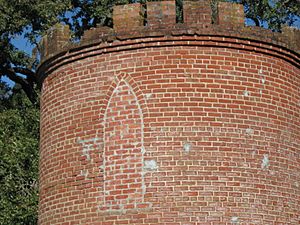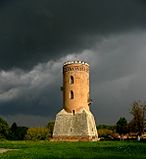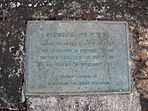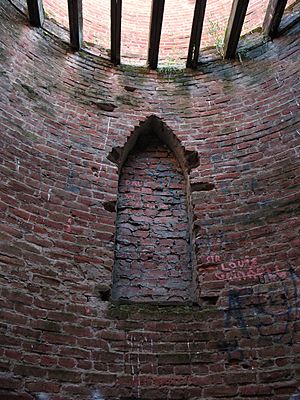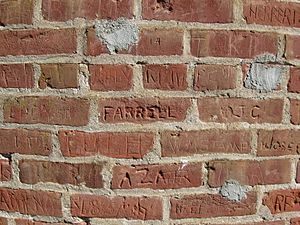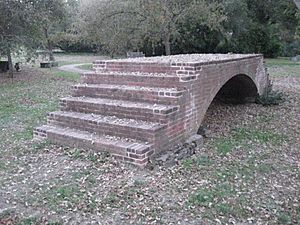Frenchman's Tower facts for kids
Quick facts for kids Frenchman's Tower |
|
|---|---|

Frenchman's Tower on Old Page Mill Road
|
|
| General information | |
| Status | Complete |
| Type | Water tower |
| Architectural style | Gothic Revival |
| Location | San Francisco peninsula |
| Address | 2065 Old Page Mill Road, Palo Alto, California |
| Town or city | Palo Alto |
| Country | United States |
| Coordinates | 37°23′46″N 122°09′43″W / 37.396132°N 122.161895°W |
| Elevation | 200 ft (61 m) |
| Completed | 1875 |
| Owner | Stanford University |
| Height | 32 ft (9.8 m) |
| Dimensions | |
| Diameter | 15 ft (4.6 m) |
| Technical details | |
| Structural system | Brick Masonry |
| Floor count | 2 |
| Design and construction | |
| Architect | Paulin Caperon (aka Peter Coutts) |
| Designations | California Point of Historical Interest |
Frenchman's Tower is a two-story building made of red bricks in Santa Clara County, California. It looks a lot like an old castle tower. It was built in 1875 and was named a California Point of Historical Interest in 1969.
The tower was built by a man named Paulin Caperon, who was from France. When he moved to Mayfield, California, in 1875, he started using the name Peter Coutts. In 1882, Coutts went back to France without telling his neighbors what happened. He asked a bank to sell his property in Mayfield.
Over the years, many people have carved their names or initials into the bricks of the tower. Some of these carvings are over 100 years old! In 1970, the owner of the land filled in the windows with bricks to help protect the tower from damage. Frenchman's Tower is located on Old Page Mill Road in Santa Clara County, California. It's on land now owned by Stanford University.
Contents
What is Frenchman's Tower?
Frenchman's Tower was built in 1875. It has small "crenels" along the top, which are like the gaps and raised parts you see on castle walls. It also has Gothic-style windows. These features make it look similar to medieval castles built many centuries ago, like the Chindia Tower. In the Middle Ages, crenels were used to protect archers defending a castle.
The second floor of the tower held a water tank. The first floor was used as a library where the original owner, Paulin Caperon, spent a lot of time reading. It's interesting that the building never had any doors, meaning people had to enter through a window!
The tower is located near Matadero Creek. It was originally connected to a system of six tunnels. These tunnels were used to bring water from underground to Caperon's farm and his lake. Workers had to dig out tons of earth to find enough underground water. The bricks for the tower were made by a company called Albert Bowman and Company. They used clay found in Mountain View in the same year the tower was built.
Why is the Tower Famous?
Over the years, many different stories have been told about Paulin Caperon's tower and tunnels. Caperon, who also used the name Peter Coutts, enjoyed making his neighbors curious. He often let these stories continue without saying if they were true or not. Some of these tales included that he built the tunnels and tower to "withstand a siege by his enemies" or that he was hiding the French Empress. None of these stories were true.
Official Recognition
- The tower was registered as a California Point of Historical Interest on November 3, 1969.
- It is listed on the Santa Clara County Heritage Resource Inventory.
- The Library of Congress has photos of Frenchman's Tower taken in 1975.
- An old photo from 1910-1930 is kept in the San Jose Public Library.
Tower in the News
Sometimes, news reports today talk about the tower as an unsolved mystery.
- In March 2011, a CBS News reporter interviewed local historian Steve Staiger. Staiger said he didn't think the tower was built just for water because it was too far from water sources. He even offered a reward to anyone who could solve the mystery! The TV report showed a hole that people had made in the back of the tower.
Historical Articles
- Peninsula Life Magazine published an article in 1948. It described Frenchman's Tower as "standing stark and alone" and one of the most famous landmarks in the area. The article shared Paulin Caperon's story through interviews with his family members.
- The California Historical Society wrote an article in 1954. It talked about the strange story of the man who sold the land to Leland Stanford. Stanford later built his university there. The article shared information from interviews with Coutts's family and household members.
- The Stanford Historical Society published an article in 1981. It explained many of Paulin Caperon's actions that seemed strange at the time.
Public Curiosity
Some articles show how curious people are about the tower.
- In 2010, a reporter described climbing over a fence and taking photos inside the tower.
- In 2006, photographer Eric Chan took pictures of the tower, both outside and inside. He said he climbed through a small hole in the back and found it "pretty scary inside." The photo on the right, showing the inside, is one of many he shared online.
Protecting the Tower
- In 2004, a report about new walking trails raised concerns. It worried that more visitors might lead to more damage to the tower. However, the report also said that more people seeing the tower might help protect it. To help, the landowner agreed to check the tower every six months and fix any new damage.
Who Was Paulin Caperon?
Jean-Baptiste Paulin Caperon was born in France in 1822 to a wealthy family. He passed away in France in September 1889 when he was 67 years old.
Paulin Caperon's father was an officer for Napoleon. Paulin lost both his parents when he was only 26. He didn't agree with the government's policies and was against the Franco-Prussian War. He started his own bank, which he sold in 1873. Because of problems in France, he left for Belgium. Then he traveled to New Orleans using the identity papers of his cousin, Peter Coutts, who had passed away. He continued to use the name Peter Coutts when he arrived in Mayfield (which is now Palo Alto).
In 1875, he bought 1,400 acres (about 4.7 square kilometers) of land from Jeremiah Clarke for $90,000. Paulin Caperon was worried about his children's future because he had a heart problem and his wife was ill. To make sure his children would inherit his property easily, he put the land's ownership in the name of their governess, Eugene Cloyensen.
Caperon turned the land into a successful farm for animals. He also oversaw the building of the tower to help distribute water. He seemed friendly but didn't like to talk about his past. When local people found out that Peter Coutts (Paulin Caperon) had bought the land in his governess's name, they became suspicious. They started guessing and spreading rumors about why the tower was built.
In 1882, only eight years after he arrived, Paulin Caperon suddenly went back to France. He sold the land for $140,000 to Leland Stanford. Stanford later founded Stanford University in 1891 on this land.
Paulin Caperon eventually got back the legal ownership of his valuable property in France. Using his real name, Caperon and his family returned to Paris in May 1883. He spent the rest of his life in France.


